Anyone who has spent a significant amount of time observing Western Grebes (or their close relatives, Clark’s Grebes) has undoubtedly observed this curious behavior multiple times.
But before I continue, a few words of explanation are in order. Grebes are unique to most other water birds in two ways that are related to this behavior: 1.) their legs are attached to their bodies at the rear, rather than underneath and 2.) the toes of grebes are lobed instead of webbed.
Having legs attached at the rear allows for efficient swimming but causes extreme clumsiness while walking – they rarely venture on to land, but when they do they often fall down after just a few steps. This leg attachment position is so distinctive of grebes that the genus name of four of the North American grebe species is Podiceps (from “podicis” meaning anus or vent and “pes” meaning foot) – in other words, “anus foot”. (and yes, I’m having a hard time resisting a joke line or two with that phrase…)
Recent experimental work with grebes has demonstrated that the lobes on the toes function much like the hydrofoil blades of a propeller.
Ok, with that background, on to this strange behavioral quirk of the Western Grebe.
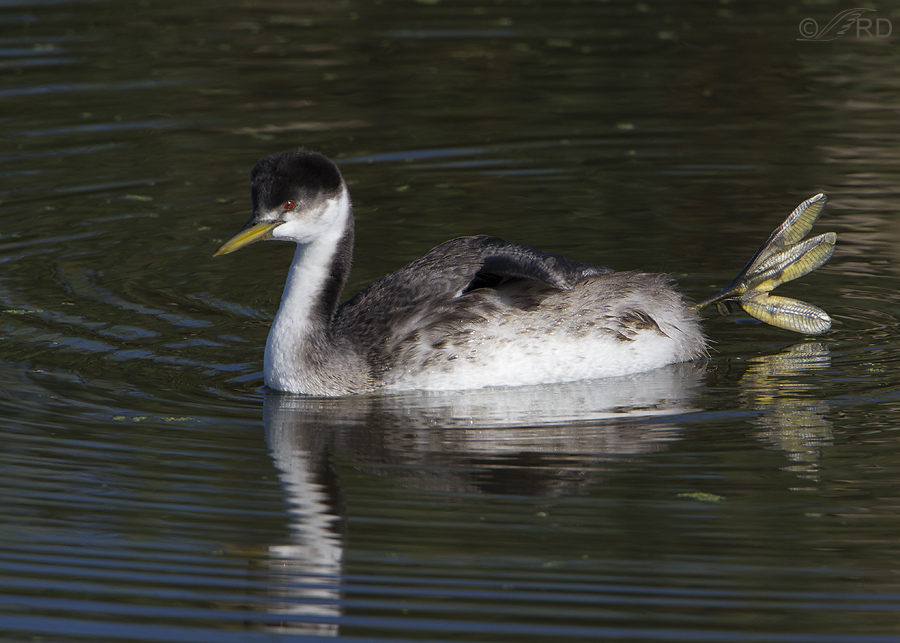
Without warning, and for no apparent reason, they stick one of their legs out behind them. With those unusual feet it can look pretty silly.
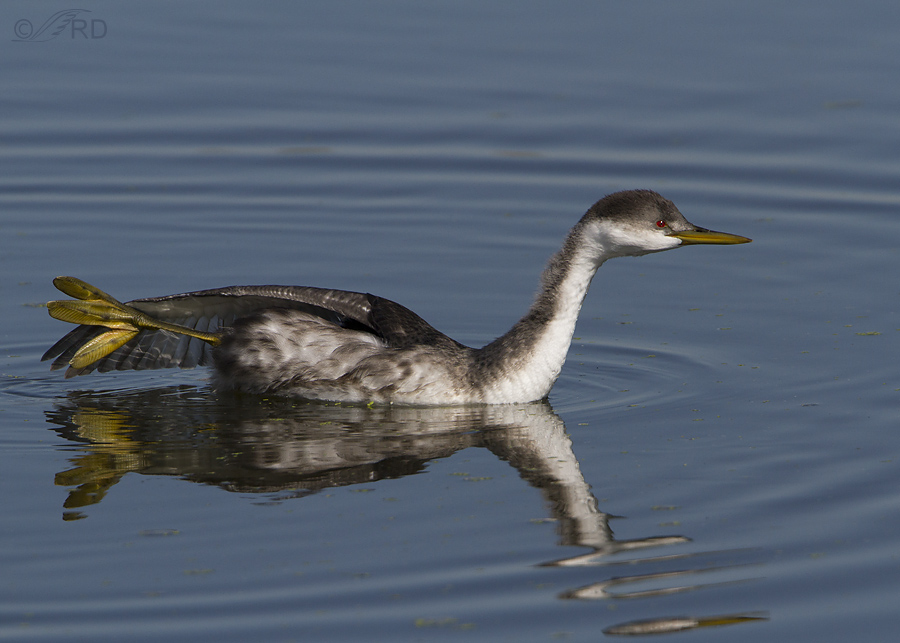
Sometimes they’ll do a simultaneous wing stretch, but rarely.
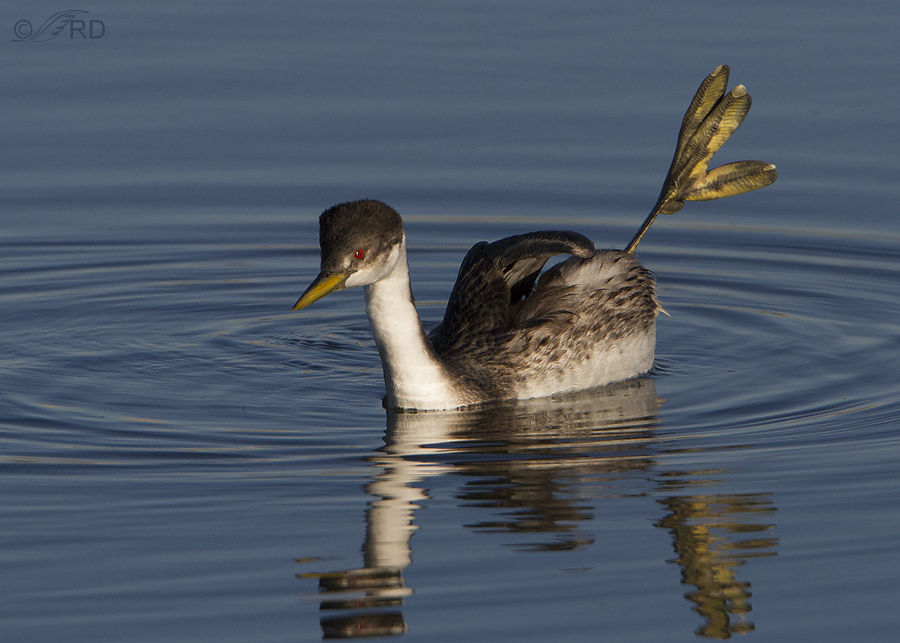
Occasionally they’ll hold the foot high in the air for quite a while. That can look even sillier.
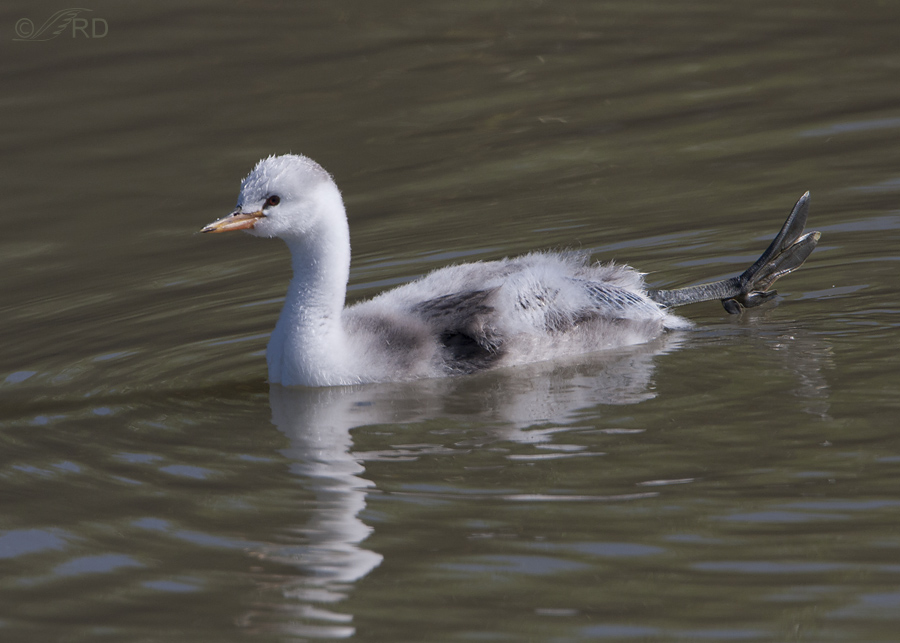
Even the chicks do it.
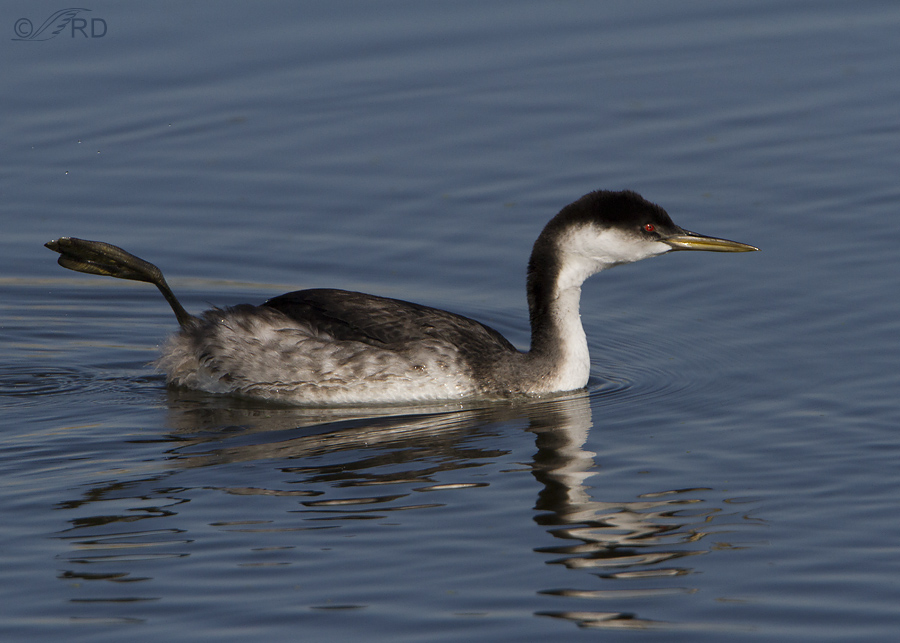
But typically they only leave the foot behind them for a few seconds, usually shaking it as you can see here from the water droplets flying through the air and hitting the water…
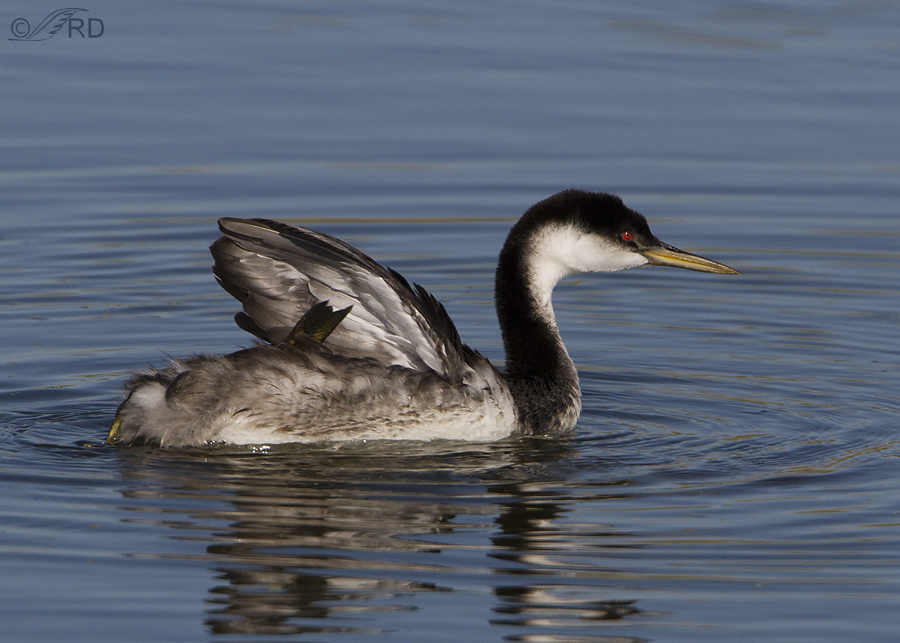
and then they either tuck the leg and foot under a wing (most common) or lay them on top of their back. Obviously this contortionist maneuver would be impossible if the legs were attached in the “normal” position, under the body.
Over the years I’ve seen grebes do this many hundreds of times and never understood it, so recently I did some research. It turns out that this behavior helps to prevent body heat from being lost to the water. They stick the foot back behind them, shake the water off, then place it under the wing to warm it and prevent further heat loss. Sometimes on sunny days they leave the foot on their back to absorb the heat from the sun.
Bird behaviorists even have a name for this neat little maneuver – it’s called “foot-shipping“. (another definition of shipping is “to put in place for use”).
Here’s a look at a grebe “shipping” its foot. The wing is raised, the foot and leg come over the body from behind…
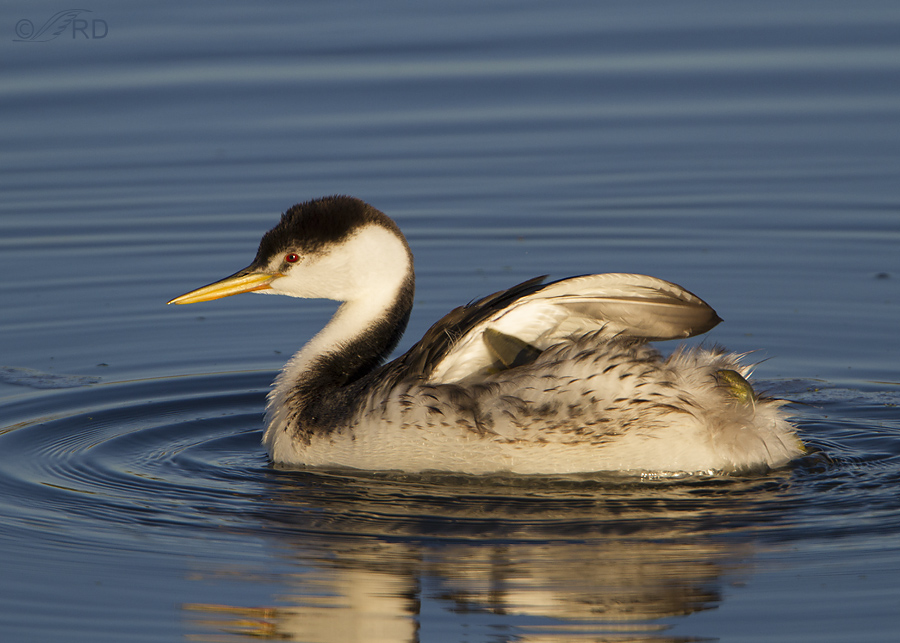
and are neatly tucked under the wing before it returns to its normal position.
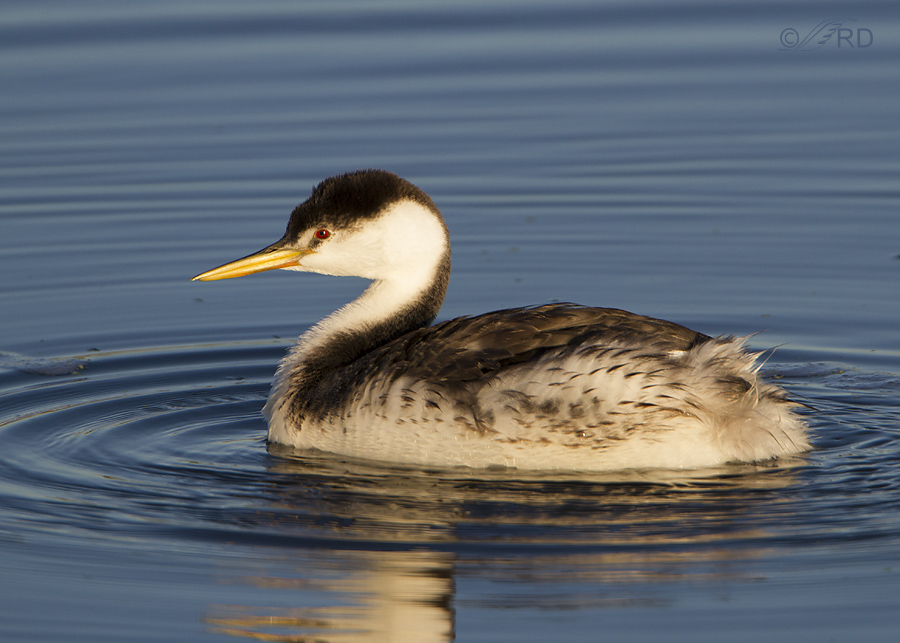
And literally a split-second later you’d never know that the leg and foot are under the wing.
This all happens very fast. I doubt most folks notice the foot going under the wing and once it’s there you’d simply assume both legs are below and behind the bird again. And they’re very good at paddling with only one foot.
I’m delighted to finally learn the answer to this little puzzle that has befuddled me for so long and I thought some of you might be interested.
I always assumed it was some form of bizarre leg stretch. As I’ve stated here before, making assumptions can sure be non-productive…
Ron


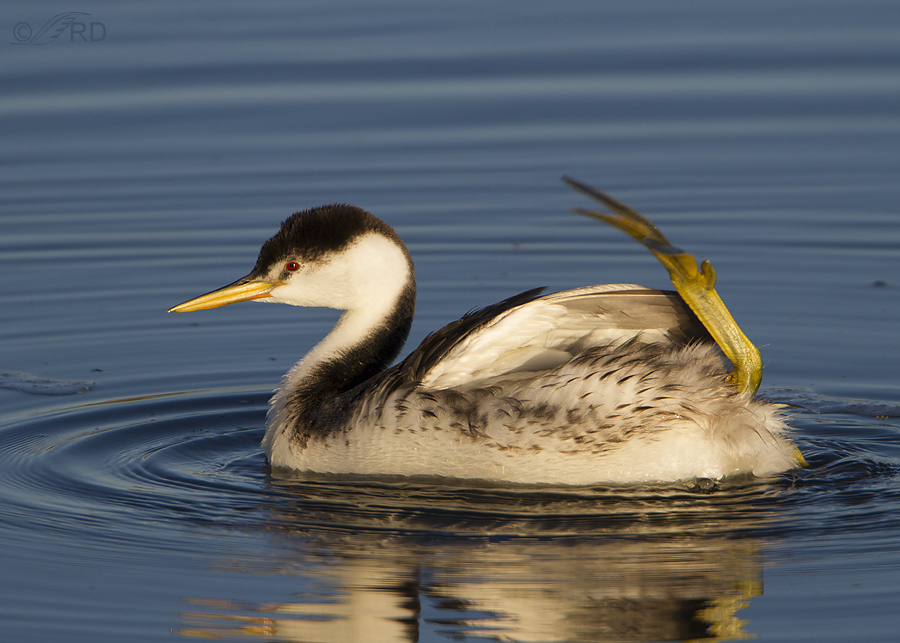
Fascinating information, Ron. My question is: Three days ago, a pair of Western Grebe’s appeared on the water of our north-central AZ 9-acre urban lake. After day one, I have seen only one grebe floating on the water. Any ideas? Would the other just take off without the other? Could it be laying eggs somewhere else? Is this the right time of year to nest? Thank you so much,
DJ
DJ, This years nesting season is over for these birds and besides they don’t nest in your area – your birds are most likely migrating through. It’s my guess that one of your grebes continued its journey without waiting for the other bird (they migrate at night).
Terrific information about Grebes and amazing photos. Do you know if Grebes have any mystical or spiritual meaning?
Thanks for explaining this interesting behaviour! I have seen other birds stretching in this manner, here on the Maplewood Mudflats in North Vancouver, BC.. It really is so much fun to learn about all the interesting behaviours that make all the species so distinctly different. What a great passion! If you ever make your way to Vancouver, please contact me.. we live on a bird sanctuary on an ocean estuary with over 240 species.. many are migratory, but there are many that reside year round. Would be honoured to host you and see how you get all these great photos!
I’m in 4th grade and I’m studying the western grebe. I wanted to use the third picture for my report, so can I?
Thanks,
Fiona
Hi Fiona,
Yes, you may use that image for your school report. You chose an interesting species of bird to study and I hope your report goes very well.
Good luck!
Ron
Great shots Ron!
We often see Common Loons here in NH doing this with there feet!
Thank you John – that’s nice to know.
I have seen this before in the Eared Grebes, it was akward and I wasn’t sure if something had happened to it, but now I know. great shots as always!
Thank you Mavourneen, interesting to know that the Eared Grebes do it too – something I’ve yet to see.
You are so patient and informative. No wonder you were a favorite teacher of my daughter. I look forward to learning and being enlightened by you. Thank you for continuing to educate us!
Tana, your comment about your daughter tugged at my heart. Thanks!
Fascinating! I now rather wish I was more conveniently located to a population of grebes, and, lacking that, will read up on them in my field guides. Thanks for the beautiful and informative post.
You’re very welcome Sid – thanks for appreciating it. Yes, I’d miss these grebes if I lived where they were absent.
Ron:
Terrific photos to illustrate the explanation of the behavior. Is it worth noting that Loons also have their legs set far back on their bodies? I don’t know if they exhibit a similar behavior.
Dave
When I was preparing this post I also wondered if loons exhibited this behavior because of their leg position and the fact that they spend so much of their time in very cold water. But I have little experience with them (and no decent photos showing the point of their leg attachment) so I didn’t mention them. Thanks for bringing it up Dave.
That’s fascinating!! Does anyone else think they look like ballerinas with the leg stretched out?
Maybe they do Nicole, but I suspect a ballerina with feet that big would certainly have some performance issues 🙂
Great and informative post. I knew nothing about this before. Okay, I’ll do the joke. It brings new meaning to having your foot up your butt. 🙂
I knew that one of the two of us couldn’t resist the joke Bob 🙂
What an interesting little bird! I never knew… Thank you for your dedication to winged critters, and then sharing with us.
Thank you YTQ, – actually these birds aren’t very “little”.
Wow. In the first three images, I would not even have recognized the thing protruding as a foot. It looks more like a branch with leaves at the end. I’ve only seen grebes from very far away and have never noticed their feet, this behavior, or even paid them much attention. I won’t be so quick to dismiss them when I next see some. Thank you for the most enlightening post.
Thanks Sharon. Yes, the magic of a photograph to slow things down really helps to notice some details that the naked eye usually misses.
How incredible. Thank you so much for the research – and for the wonderfully illustrative photo series as well. A bizarre looking foot indeed.
Yes, that foot gets your attention, doesn’t it Elephant’s Child?